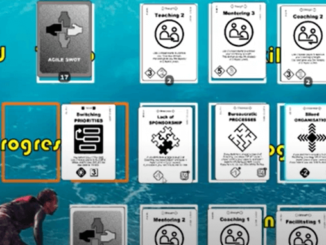
On National Boardgame Day (in the UK) Ludogogy launched its fortnightly game design challenge, on LinkedIn.
The idea is to give a challenge that will be interesting, but hopefully not too time-consuming, to get our creative juices flowing, and make games design a part of our regular practice.
Responses are invited at whatever level of depth that participants want, from a simple comment to a full-blown design – and everything in between.
The Challenge on 11th April was:
- Uses a deck of playing cards (you can add other materials/kit)
- Is inspired by / in some way uses, the moves of chess pieces (be as literal or figuarative as you like here)
- Can be explained fully in no more than 300 words
- Can be played solo as well as with up to four players
and for those who wanted to make it into a learning game there was an additional parameter.
- Supports learning outcomes around strategic thinking
Even though you are now reading this in Ludogogy, it’s not too late to respond to this challenge if you want. Comment below and I’ll your design idea to this post.
Three intrepid designers responded to this challenge.

From Terry Pearce comes the following:
Components: a 52-card deck of cards, chess board and 64 counters.
Deal five cards each. Each sit on a random side of the chess board. Choose starting player randomly. On your turn: discard one card. Replace it from the top of the deck. Play then proceeds to the left.
When you discard a card, cover two squares of the chess board with counters from the central pool. The first square can be anywhere. The second square must be a square which a chess piece (determined by the value of your discarded card) could legally move to, had it started on your first space, as follows:
K=King
Q=Queen
J=Rook
10=Bishop
9=Knight
8-A=Pawn* Pawns can only move ‘away’ from you as you face the board, not diagonally or sideways
* You may not ‘Castle’
* It doesn’t matter if the squares between your first and second are emptyIf you can’t make a legal move, the player to your right may ‘steal’ your turn, playing a card instead. If they can’t, the player to their right (if playing with 3) may steal, and if they can’t, the player to their right (if playing with 4) may. After one player makes an extra move this way, play continues normally from the player to the left of the player who originally couldn’t play.
Any time you can’t play, discard your hand and draw a new one. If the cards run out, shuffle discards to create a new deck.
The winner is the player who covers the final square (including doing so on a ‘stolen’ turn).
Solo play: Play with a ‘bot’ 2nd player, who plays a random card from the top of the deck each turn. There is no stealing — in the absence of a legal play, miss a turn.
And Paul O’Connor submitted this variant on Loser Chess.
First player to lose all pieces wins. Standard chess board, and pieces layout and face-down deck of playing cards.
Standard chess rules, but no castling or en-passant and King can be captured like a normal piece, but if so, game ends! Player with most pieces remaining loses. If a piece can capture it must try to do so.
Players select a piece to move. Reveal the top card. Card number (ace=1/Queen=12) dictates max no. of squares the selected piece _must_ move (unless a pawn=max2 squares). Must draw a King card (=13) to capture a king!
If the selected piece fails to move far enough, it stalls on the last square, or, if a Knight it stalls, fails to jump and remains in-situ. [Order: Select piece to be moved-reveal Movement Card-Move piece (or stall)-capture if successful-End of turn].
Priority Moves; King must react to check, if possible. If a choice of multiple possible captures, the moving player selects their target _before_ revealing the movement card!
Cat Hase gave us this point-based game, with lots of potential for different strategies
🃏 Shuffle a deck of cards and then lay them out in an 8×8 grid (like a chess board), face up so you can see the values.
♟ Each player then selects 2 chess pieces whose moving pattern they may use (choice between Rook, Bishop, Knight) and assigns one move pattern to each of their 2 player pieces.
🃏 Each player starts at one of the corner squares (chosen at random).
♟ Each player then takes turns to take one move each.
🃏 The aim is to move your pieces in ascending order around the board, noting down each number you cover. (players are unlikely to be able to count every number, so much choose which way to do and which numbers or counts to miss out for the sake of future moves!)
♟ Players can introduce their second piece at any time, from the same corner.
🃏 Only one player piece can cover a single card at one time, but all cards can be visited as often as needed.
♟ Once players have reached the highest number they can with their legal moves, they exit the game and add up the total number of points they’ve scored.
🃏 Play continues until all players have exhausted their legal moves.
♟ The person with the highest score wins.
🃏 In solo mode you can use 3 pieces with each one starting in a different corner.
♟ Extra levels can be added by increasing the size of the grid, introducing a third player piece or introducing the queen (which I assume should make it easier!)
Paul Kreutzer takes the prize (so far) for the most succinct description of a game with:
- I thought that given Chess’s binary division into black and white, and cards’ suits divided into reds and blacks, something might be done by some card bidding for the right to move.
- I think: Players draw 7 cards. Simultaneously play any card to bid for each turn, highest card wins. Losing player may challenge by playing a set of their color, and so on until one side wins and takes a Chess turn.
- If a capture occurs, player may bid for a repeat turn by playing a set of their color. Refresh hand to seven at end of opponent’s turn. May replace cards in hand at 2:1 discard rate.
- Jokers wild, cancel previously played cards.
My own response is not completely formed yet, and in any case cannot currently be described in under 300 words – but will follow soon.
- James Bore – The Ransomeware Game - 13th February 2024
- Ipsodeckso – Risky Business - 23rd January 2024
- Review – Luma World Games - 15th December 2023





Be the first to comment